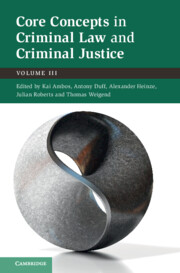Book contents
- Core Concepts in Criminal Law and Criminal Justice
- Core Concepts in Criminal Law and Criminal Justice
- Copyright page
- Contents
- About the Authors
- Abbreviations
- 1 Introduction to Volume III
- Part I Criminal Law
- Part II Criminal Procedure
- 8 Beyond a Reasonable Doubt and Intime Conviction
- 9 Pretext, Deception and Entrapment in Criminal Investigations
- Part III Criminal Justice
- Index
- References
8 - Beyond a Reasonable Doubt and Intime Conviction
from Part II - Criminal Procedure
Published online by Cambridge University Press: 09 July 2025
- Core Concepts in Criminal Law and Criminal Justice
- Core Concepts in Criminal Law and Criminal Justice
- Copyright page
- Contents
- About the Authors
- Abbreviations
- 1 Introduction to Volume III
- Part I Criminal Law
- Part II Criminal Procedure
- 8 Beyond a Reasonable Doubt and Intime Conviction
- 9 Pretext, Deception and Entrapment in Criminal Investigations
- Part III Criminal Justice
- Index
- References
Summary
This chapter deals with ‘intime conviction’ and ‘beyond a reasonable doubt’ as ways in which fact-finders (professional judges or lay juries) in criminal trials decide on the question of guilt. The ‘beyond a reasonable doubt’ standard is typically associated with the Anglo-American system of criminal justice, whereas intime conviction is a characteristic feature of Continental procedural systems. Both standards belong to the phase of the evaluation and assessment of evidence in the criminal trial procedure. The chapter considers the way in which the two systems have converged on essentially the same standard of proof but have taken different paths towards it, with parallel discussions taking place along the way. The chapter discusses the definition of the ‘beyond a reasonable doubt’ standard in detail and introduces several important questions that have arisen around the two standards, such as those concerning definition and application of the standards, and how such issues have been resolved in the two different systems, and notes a few significant remaining differences.
Keywords
Information
- Type
- Chapter
- Information
- Core Concepts in Criminal Law and Criminal JusticeVolume III, pp. 263 - 304Publisher: Cambridge University PressPrint publication year: 2025
References
Accessibility standard: WCAG 2.1 AA
Why this information is here
This section outlines the accessibility features of this content - including support for screen readers, full keyboard navigation and high-contrast display options. This may not be relevant for you.Accessibility Information
Content Navigation
Allows you to navigate directly to chapters, sections, or non‐text items through a linked table of contents, reducing the need for extensive scrolling.
Provides an interactive index, letting you go straight to where a term or subject appears in the text without manual searching.
Reading Order & Textual Equivalents
You will encounter all content (including footnotes, captions, etc.) in a clear, sequential flow, making it easier to follow with assistive tools like screen readers.
You get concise descriptions (for images, charts, or media clips), ensuring you do not miss crucial information when visual or audio elements are not accessible.
Visual Accessibility
You will still understand key ideas or prompts without relying solely on colour, which is especially helpful if you have colour vision deficiencies.
Structural and Technical Features
You gain clarity from ARIA (Accessible Rich Internet Applications) roles and attributes, as they help assistive technologies interpret how each part of the content functions.
